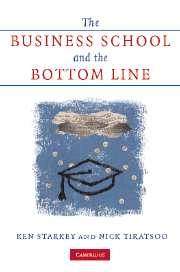Book contents
- Frontmatter
- Contents
- List of tables
- Acknowledgements
- Prologue
- 1 Introduction
- 2 The development and diffusion of the business school
- 3 Business schools in the era of hyper-competition: ‘more “business” and less “school”’
- 4 Business school education
- 5 Business school research
- 6 Experiments and innovations
- 7 Imaginary MBAs
- 8 Business school futures: mission impossible?
- Epilogue
- Index
3 - Business schools in the era of hyper-competition: ‘more “business” and less “school”’
Published online by Cambridge University Press: 02 December 2009
- Frontmatter
- Contents
- List of tables
- Acknowledgements
- Prologue
- 1 Introduction
- 2 The development and diffusion of the business school
- 3 Business schools in the era of hyper-competition: ‘more “business” and less “school”’
- 4 Business school education
- 5 Business school research
- 6 Experiments and innovations
- 7 Imaginary MBAs
- 8 Business school futures: mission impossible?
- Epilogue
- Index
Summary
In the previous chapter we have described how the business school sector developed wordwide, underlining, amongst other things, the recent extraordinary growth of provision. Next, we turn to look in more detail at what is occurring today. We begin by observing that schools are currently having to compete as never before, and then go on to explore how they are reacting, taking in both short-term and medium-term strategies. Our argument in a nutshell is that competition is forcing schools everywhere to become very much more hard-nosed: in the memorable formulation of one anonymous dean, ‘more “business” and less “school” ’.
INCREASING COMPETITION
The basic fact nowadays is that few if any business schools can take their continued existence wholly for granted. The sheer number of schools in itself breeds competition, of course. Nottingham is a medium-sized city in the English Midlands. It has two well-rated business schools offering a wide variety of programmes. But it is also in close proximity to three other cities that have notable business schools, while prestigious institutions such as London Business School, Cranfield and the Said Business School at Oxford are only a couple of hours away by car or train. In Los Angeles no fewer than fifteen large graduate business programmes run side by side. The Australian case is even more extreme: the country has a total population of only 19.5 million, but thirty-four different MBA degrees. The fact is that, everywhere, schools find themselves pitted against each other. The scale of this competition has been magnified by some recent changes in the wider economic and institutional environments, however, and these are worth exploring in a little detail.
- Type
- Chapter
- Information
- The Business School and the Bottom Line , pp. 50 - 76Publisher: Cambridge University PressPrint publication year: 2007

